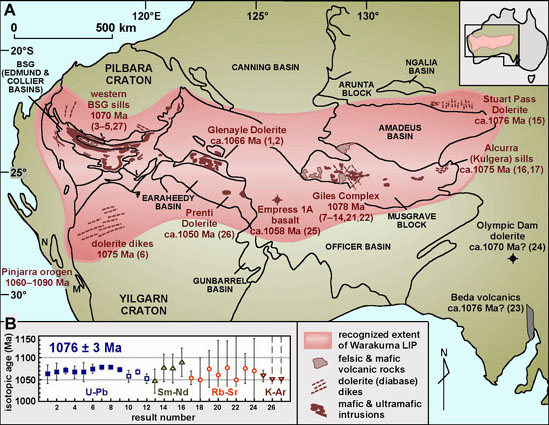January 2004 LIP of the Month
(corresponds to "Giles" event, #88 in LIP record database)
The Warakurna large igneous province: A new Mesoproterozoic large igneous province in west-central Australia
Michael T.D. Wingate
Tectonics Special Research Centre,
School of Earth and Geographical Sciences,
University of Western Australia, Crawley 6009,
Western Australia
Franco Pirajno
Paul A. Morris
Geological Survey of Western Australia,
100 Plain Street, East Perth 6004,
Western Australia
Published in February 2004 issue of Geology
Download full article in PDF format.
contributed by M. Wingate mwingate@tsrc.uwa.edu.au

Simplified geology of southwest Australia, showing the distribution of ca. 1075 Ma igneous rocks of the Warakurna large igneous province (LIP). Numbers after rock ages refer to plot B. BSG—Bangemall Supergroup; N—Northampton inlier; M—Mullingarra inlier. B: Isotopic age determinations for rocks of the Warakurna LIP, grouped according to isotopic system. Error bars are ±2s or 95%; no precision was reported for results 26 and 27. The age of 1076 ± 3 Ma is the weighted mean of U-Pb ages 1–9 (solid symbols) and is interpreted as the best estimate of the age of the main phase of magmatism associated with the Warakurna LIP.
Abstract
Coeval mafic igneous rocks emplaced rapidly over ~1,500,000 km2 in western and central Australia represent the erosional remnants of a late Mesoproterozoic large igneous province, named here the “Warakurna large igneous province.” SHRIMP U-Pb dating of rocks separated by up to 1500 km indicates that the main episode of magmatism occurred between 1078 and ca. 1070 Ma. The Warakurna large igneous province includes layered mafic-ultramafic intrusions and mafic to felsic volcanic rocks and dikes in central Australia, a 1000-km-long mafic sill province in Western Australia, and several swarms of mafic dikes. The large areal extent and short duration imply emplacement above a mantle-plume head. Despite their wide separation, the mafic rocks have similar MORB (mid-ocean-ridge basalt)–normalized trace element patterns and rare earth element characteristics. West-directed paleocurrents, westward radiating dike swarms, and the occurrence of high-Mg rocks indicate that the center of the plume head was located beneath central Australia. Other late Mesoproterozoic large igneous provinces, in the Laurentia and Kalahari cratons, appear to be significantly older than the Warakurna large igneous province in Australia and thus are unlikely to be related to the same mantle-plume head.
Whole-rock lithogeochemical data for the Warakurna Large Igneous Province project
Whole-rock lithogeochemical data for 1465 Ma and 1070 Ma dolerites from the Bangemall Supergroup in Western Australia, many of which comprise part of the Warakurna Large Igneous Province project are now available. Analytical data comprise major element chemistry, up to 32 trace elements, REE (La-Lu) for most samples, and a compilation of analytical conditions. An accompanying file contains 21 analyses of an inhouse reference material. Sampling, preparation, and analytical methods are contained in a text file.
Download for free at http://www.doir.wa.gov.au/gswa and select Products and Services, then Data Downloads.